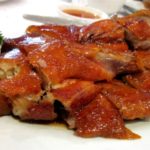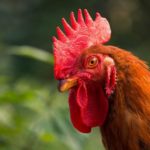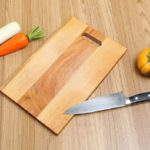There is a common misconception that thawing meat and fish are the same processes, but this is not the case. Each type of food requires a different approach to ensure the best results. Below are the correct methods for thawing meat and fish to preserve their delicious flavors.
1 How to Thaw Meat
First, prepare a basin and mix four parts cold water with one part hot water to create warm water at approximately 40 degrees Celsius.
 Mix four parts cold water with one part hot water to create warm water.
Mix four parts cold water with one part hot water to create warm water.
Next, add one tablespoon of sugar and stir until dissolved.
 Add one tablespoon of sugar and stir.
Add one tablespoon of sugar and stir.
Now, soak the frozen meat in this mixture.
After 10 minutes of soaking, the meat will be soft and tender again. The sugar helps tenderize the meat and enhance its natural sweetness, while the acid in the lemon prevents bacterial growth.
 Soak the meat for 10 minutes to thaw.
Soak the meat for 10 minutes to thaw.
2 How to Thaw Fish
Similarly, prepare a basin with four parts cold water and one part hot water to create warm water at 40 degrees Celsius.
For fish, instead of sugar, add one tablespoon of salt and stir until dissolved.
 Create a brine solution by mixing salt with warm water.
Create a brine solution by mixing salt with warm water.
Finally, soak the fish in this mixture for about 10 minutes. While sugar tenderizes meat, salt firms up the fish’s flesh, resulting in a more flavorful dish when cooked.
 Soak the fish for 10 minutes to thaw.
Soak the fish for 10 minutes to thaw.
3 Alternative Thawing Methods
Using Metal for Thawing
Metal is an excellent heat conductor, which can help speed up the thawing process. With this method, simply place or clamp the frozen food between two flat metal surfaces for about 10 minutes to achieve effective thawing.
Slow Thawing in the Fridge
If you have more time, the best and safest option is to thaw your food slowly in the refrigerator. This method ensures food safety and prevents bacterial growth.
 Slowly thaw food in the refrigerator.
Slowly thaw food in the refrigerator.
Using a Microwave to Thaw
Microwaves can quickly thaw meat and fish, but this method is only suitable if you intend to cook the food immediately afterward. Leaving thawed food from the microwave at room temperature can promote bacterial growth and compromise food safety.
 Thaw food in the microwave only if you plan to cook it immediately.
Thaw food in the microwave only if you plan to cook it immediately.
These methods will help you quickly thaw meat and fish while maintaining their texture and nutritional value. Give them a try, and don’t forget to follow us for more useful tips!
Unlocking the Simple Solution to Combatting Odors of All Types of Meat
In order to ensure that your meat-based dishes not only taste great, but also do not give off any unpleasant odor, it is essential to find ways to deodorize popular meats such as beef, pork, chicken, and fish.
8 Common Mistakes People Make with Cutting Boards
Are you using your cutting board correctly? Many Vietnamese households rely on cutting boards in their kitchen, but not everyone knows how to use them properly, especially when it comes to wooden cutting boards. Check out these 8 mistakes to avoid when using a cutting board to ensure both hygiene and safety for everyone in your family.
Is Refrigerated Leftovers Linked to an Increased Risk of Cancer?
Dr. Lam Van Man, Head of Research, Development and Technology Transfer Department of the Institute of Safety Food, has warned of the risk of food poisoning when reheating leftovers from the refrigerator. But what should we be aware of when it comes to the possibility of these leftovers causing cancer? Here, we explore what the experts have to say on the matter and offer some tips for safe eating.





































